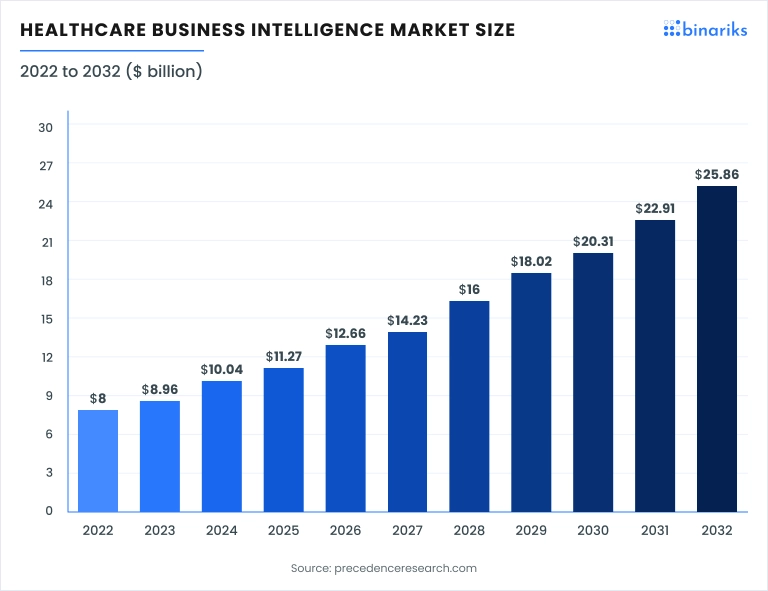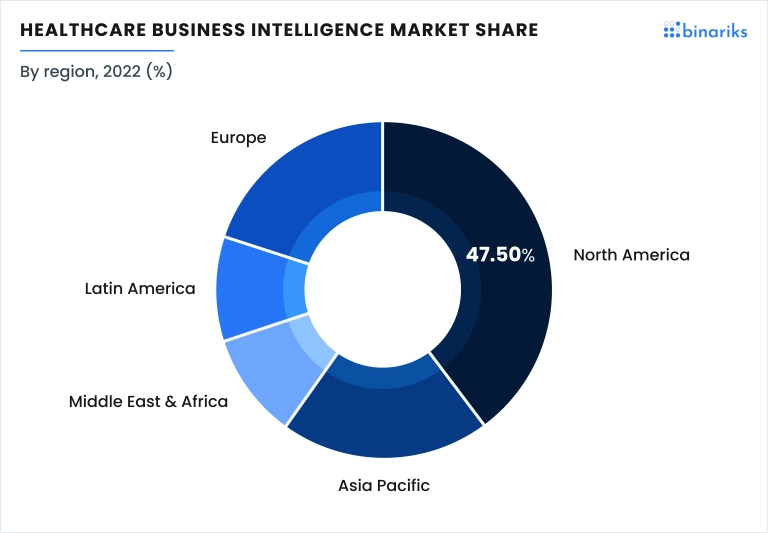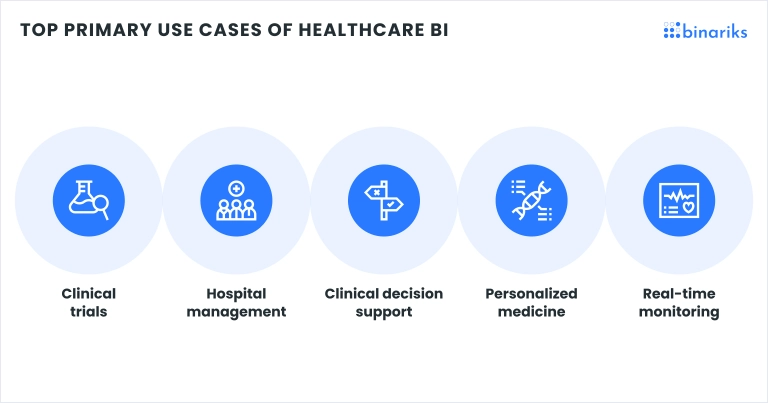Business Intelligence (BI) is a technology-driven process for analyzing data and presenting actionable information for better decisions . In healthcare, it involves analyzing data to help improve the efficiency and effectiveness of health services.
BI comprises data collection, mining, storage, and processing, as well as visualization, predictive analytics, and performance management. BI is paramount in healthcare as it plays a role in healthcare providers' clinical decisions , the financial and operational management of the healthcare organization, and even population health.
Let's delve deeper into the concept of healthcare BI by exploring its components, benefits, use cases, and real-life examples.
Business intelligence in healthcare: Statistics & facts

Business intelligence in healthcare is becoming increasingly popular due to its unique ability to simultaneously improve patient care and optimize operational efficiency. Here are some current statistics on business intelligence in the healthcare industry that demonstrate its value and relevance for the industry:
- The market for business intelligence in healthcare is expected to grow at a CAGR of 12.30%, reaching a value of $25.86 billion by 2032. In the US, it is expected to reach 8.36 billion. This growth is driven by both the need to manage chronic disorders and technological advancements across the healthcare sector, including advancements in remote patient monitoring (Source ).
- Around 66% of US healthcare providers have embraced predictive analytics, a key component of BI (Source ). The healthcare industry is one of the leaders in embracing business intelligence compared to the overall BI adoption of just 26% in sectors like insurance business development .
- The leaders in embracing predictive analytics are Singapore (93%), China (79%), the USA and Brazil (66%), Germany (54%) and South Africa (33%)(Source ).
- North America leads the BI market with a revenue share of 47.5%(Source ).
- The revenue share of the financial analytics segment of BI for healthcare is the highest at 38%, with the patient care segment being the fastest-growing.
- Cloud-based healthcare business intelligence tools are the most popular by mode of delivery.

Healthcare business intelligence components
BI for healthcare is meant to gather information from multiple sources. Here are the four main components of business intelligence:
- Extract, transform, and load (ETL)
This process involves extracting data from multiple sources, transforming it into a consistent format, and loading it into a data warehouse. ETL is foundational for ensuring data is accurate, complete, and available for analysis.
- Enterprise data warehouse (EDW)
An EDW serves as the central repository for the organization's data. It consolidates data from various sources, making it easier to perform comprehensive analyses. An EDW supports complex queries and stores historical data, which is crucial for trend analysis and long-term planning in healthcare. Unlike the previous step, this one also analyzes the data.
- Data mining and discovery
This involves exploring large datasets to find patterns, correlations, and insights that are not readily apparent. In healthcare, data mining can reveal trends in patient outcomes, treatment efficacy, and resource utilization. Strategic decisions are made based on data mining and discovery findings.
- Data visualization and reporting
Visualization tools and reporting systems help translate data into understandable and actionable information. Effective data visualization in healthcare can lead to quicker and more accurate decisions by presenting complex data intuitively. This includes dashboards, graphs, and charts that provide real-time insights into operational performance, patient statistics, and more.
7 benefits of embedded BI in healthcare
The benefits of BI for healthcare are multidimensional as they span from improved patient care and higher quality of treatment to optimizing the hospital's internal processes. Here are the most important benefits to look forward to:
1. Improved decision-making
Embedded BI in healthcare allows healthcare professionals to access real-time data and analytics within their workflow. This immediacy helps clinicians and administrators make informed decisions quickly. Traditional data analysis involved physicians requesting reports from the data team.
However, BI for supporting healthcare professionals actually eliminates the middleman and allows physicians to extract data insights themselves.
Self-service BI tools are also available for patients, who receive quick access to their personal data.
2. Enhanced patient care
With analytics embedded directly in patient management systems, clinicians can gain insights into a patient's medical and family history, treatment outcomes, and potential risks without switching between systems.
Medical care providers can identify patients at risk of complications and take proactive measures to prevent them. All of this leads to better diagnostic accuracy , personalized treatment plans, and overall improved patient outcomes. Satisfied patients are the best way to attract new patients.
3. Increased operational efficiency
Embedded BI tools can automate routine data analysis tasks, freeing staff to focus more on patient care than data management. Additionally, these tools can help optimize hospital operations, from staffing and scheduling to inventory management, by providing data-driven insights directly within the operational tools.
Business intelligence software in healthcare can also streamline processes for peak performance hours to minimize wait times.
4. Cost reduction
The role of healthcare BI in patient care includes significantly reducing costs. By optimizing processes and improving resource allocation through data-driven insights, healthcare providers can lower operational costs. Healthcare BI solutions help get the trends that lead to a better understanding of patient inflow and logistics. Embedded BI in healthcare helps identify inefficiencies and areas where costs can be cut without compromising the quality of care.
Moreover, improving patient outcomes can also save patient care costs. Predictive healthcare analytics reduces the need for emergency health interventions, as health issues can be addressed early on. Increased operational efficiency and cost reduction can free up resources for investment in better equipment and new patient services.
5. Compliance and reporting
Healthcare is a highly regulated industry that requires stringent compliance with various legal and safety standards.
Embedded BI can help organizations monitor compliance in real time and automatically generate reports that meet regulatory requirements.
6. Enhanced user adoption
Because embedded BI in healthcare is integrated into applications that staff are already familiar with, it typically sees higher adoption rates than standalone BI tools. Higher adoption leads to more comprehensive data analysis and better overall outcomes.
7. Scalability, customization, and data sharing
Embedded BI solutions can be customized to meet a healthcare organization's specific needs and scaled as those needs change. This flexibility ensures that healthcare providers can continue to benefit from BI as they grow and evolve.
Healthcare BI solutions are also great at unifying and sharing data from multiple sources. They allow clinicians to compare a particular patient's symptoms with nationwide data.
Unlock your data's potential: discover Binariks' big data and analytics services today!
Use cases of business intelligence in healthcare

There are hundreds of ways of using BI in healthcare, but hospitals and other healthcare companies have limited resources, so they have to prioritize what's important to them. Below is the list of the most helpful use cases of BI in healthcare:
Clinical trials
- Healthcare BI tools enhance the efficiency and effectiveness of clinical trials. By analyzing data from past trials, researchers can identify patterns and predictors of outcomes to better design future studies. Healthcare BI also helps in patient selection by identifying suitable candidates based on historical data, which can increase the likelihood of successful outcomes. For instance, a pharmaceutical company can use BI to pinpoint the ideal demographic and medical profiles for participants in a trial for a new diabetes drug.
- Moreover, real-time data monitoring ensures that adverse reactions or anomalies are caught early, potentially saving lives and resources. This is one of the clear benefits of BI in healthcare for safety and compliance.
- By leveraging business intelligence software, healthcare professionals can conduct more effective clinical trials, thereby reducing the time to market for drugs discovered during drug trials.
Hospital management
- In hospital management, healthcare BI applications help in resource allocation, patient flow management, and operational efficiency. Hospitals use BI to analyze everything from bed utilization rates to patients' average time in the emergency department. This information helps administrators optimize staffing schedules, manage supply chains, and improve hospital operations to reduce costs and enhance patient care.
- In one particular example, hospitals use BI tools to manage capacity. This includes everything from admission rates and discharge rates to bed occupancy. For example, a BI system might predict peak admission times in an emergency department and adjust staffing and bed availability.
- BI tools help hospitals track and analyze financial data such as expenditures, service revenue, and insurance claims processing. This analysis supports financial planning and identifies areas for cost reduction.
- Business intelligence in the healthcare industry also helps to optimize staffing and reduce the workload. This saves hiring costs and allows healthcare professionals to avoid burnout.
- Healthcare business intelligence also effectively prevents fraud in hospitals, including insurance fraud and healthcare system abuses.
- The supply chain in hospitals and healthcare organizations can be analyzed through inventory, purchasing, and distribution analysis. It helps eliminate the risk of expiring inventory.
Clinical decision support
- BI tools provide clinicians with actionable insights derived from vast patient data. This includes predictive analytics for patient risk assessment, which helps physicians make better-informed decisions about diagnoses and treatments. For example, a BI system might analyze data from various patients to predict who is at risk of developing a particular condition.
- Healthcare BI systems use predictive analytics to identify patients at risk of chronic diseases like diabetes or heart failure based on their medical history, lifestyle data, and other determinants. Clinicians can use this information to implement preventive measures or tailor treatment strategies. Patients with chronic diseases can be tracked with IoT wearable devices , significantly improving their quality of life.
- Healthcare BI tools also analyze outcomes from various treatment protocols to determine the most effective approaches for different patient groups for better treatment outcomes.
Personalized medicine
- Personalized medicine is another area where BI is making a significant impact. BI tools can help tailor treatments to individual patients by analyzing genetic information alongside clinical data. This approach improves the efficacy of treatments and minimizes side effects by considering each patient's unique genetic makeup, lifestyle, and existing conditions.
- BI integrates genomic data with clinical outcomes to tailor drug prescriptions and other treatments to individual patients' genetic profiles. This can improve treatment and reduce side effects.
- By analyzing long-term patient data, BI helps develop personalized treatment plans that account for the individual characteristics of patients with chronic conditions.
Real-time monitoring
- Real-time data monitoring in healthcare settings is crucial for patient safety and care quality. BI tools help monitor vital signs, lab results, and other patient data in real time, providing alerts to healthcare providers when patient conditions deteriorate or require immediate intervention. This capability is especially critical in intensive care and emergency departments.
- In critical care, BI systems analyze real-time data from ICU monitoring equipment to detect early signs of deterioration in patients.
- Healthcare business intelligence solutions collect and analyze data from remote devices worn by patients. This allows healthcare providers to continuously monitor patients' health statuses, such as blood sugar levels or heart rates, and intervene as soon as troubling signs are detected.
Examples of successful implementation of BI in healthcare
How do actual healthcare organizations implement business intelligence software? Let's examine two famous US clinics as examples.
Cleveland Clinic
Cleveland Clinic is one of the earliest adepts of business intelligence for healthcare companies. The clinic uses healthcare business intelligence with its Virtual Command Center to enhance hospital operations. This healthcare business intelligence software is used for multiple purposes, including managing resources, streamlining wait times, and accessing the availability of beds.
Additionally, Cleveland Clinic has established a long-term partnership with IBM to create the Discovery Accelerator. This collaboration aims to transform how biomedical research is conducted. It integrates business intelligence for healthcare to improve outcomes in genomics and population health (Source ).
Mayo Clinic
Mayo Clinic successfully utilizes healthcare business intelligence for multiple purposes. First, it uses BI solutions to identify and treat rare diseases and create personalized treatment plans for patients with multiple conflicting diagnoses.
A unified Optum Labs database is used to achieve these goals.
Mayo Clinic shares its expertise with other clinics in the US and Mexico by allowing them to use their expertise and consult with their clinicians (Source ). The clinic also uses BI upgrades to utilize team performance and track various operational management metrics.
Data protection and privacy in healthcare BI
Healthcare business intelligence uses a combination of different data sources, including medical, administrative, and demographic data, which adds to the complexities of data protection in the context of healthcare BI. Most of the companies pursuing hospital business intelligence will be primarily concerned with following HIPAA standards and adapting traditional security measures to eliminate the possibilities for data breaches, including:
- Encryption both at rest and in transit to ensure unauthorized access is prevented.
- Access controls and audit trails to monitor who accesses data and what they do with it.
- Data anonymization techniques to ensure that personal identifiers are removed from the data sets used in BI analysis.
HIPAA does not name specific best practices that must be followed; it is the result of preventing unauthorized access that matters. Companies should also be aware of a growing trend of security breaches from IoT devices. Protecting data while using third-party healthcare BI tools is also a challenge.
Extensible security policies that are flexible and allow for integrating new security measures without overhauling the existing infrastructure appear to be a best-course scenario.
Want to become HIPAA-compliant?
FHIR implementation guide

Top BI tools for decision-making in healthcare
Now that we have covered use cases with examples let's look into what the market offers regarding business intelligence software in healthcare. Here is the overview of the most prevalent healthcare business intelligence software:
Tableau
Tableau is a popular data visualization tool. It allows healthcare professionals to create interactive and shareable dashboards, understand complex data sets related to patient care and hospital administration, and share them across teams.
Tableau has a user-friendly interface and intuitive learning experience, and it is quite accessible to a wide range of professionals due to its low learning curve. It is best suited for small datasets.
Microsoft Power BI
Microsoft Power BI is known for its integration capabilities with other Microsoft products and services. It offers comprehensive analytics tools that include real-time dashboard updates, data warehousing, and the ability to handle large datasets, which is crucial for hospital data management.
Compared to Tableau, Microsoft Power BI has more robust data processing capabilities to analyze more complex big data. Microsoft Power BI is one of the healthcare BI tools capable of advanced anomaly detection. However, it has a more complicated learning curve than other healthcare BI solutions, and the toll has Azure-only deployment.
Qlik
Qlik offers intuitive healthcare BI tools that support dynamic data visualizations and user-driven exploration. Its associative data indexing allows users to explore complex data and make discoveries that could be missed with query-based BI tools. This feature helps uncover trends in patient data or operational performance.
Qlik uses a wide range of different sources and is not limited to a particular cloud. Its limitations are lower visualization capabilities and limited data extraction.
IBM Cognos Analytics
IBM Cognos is a robust enterprise-level BI tool with detailed analysis, automated reporting, and scorecarding. Due to its scalable infrastructure, it is well-suited for large healthcare organizations needing extensive data integration and complex reporting capabilities.
However, IBM Cognos is not easy for non-professionals to use, and it has limited support for unstructured data sources.
Sisense
Sisense is known for simplifying complex data and making it accessible to users at all levels within a healthcare organization. Its drag-and-drop interface allows non-technical users to create detailed reports and dashboards, which is a step towards democratizing data analysis in healthcare environments.
Moreover, it can handle vast amounts of data with fast response times. However, it should be mentioned that customization with Sisense is limited.
Domo
Domo is noted for its cloud-first approach. It offers a fully mobile, integrated suite for building dashboards and performing complex analyses.
This tool is particularly effective for healthcare administrators who need to make informed decisions on the go.
SAS Business Intelligence
Known for its advanced analytics, SAS BI provides predictive analytics and data mining capabilities, which are crucial for predictive health management and risk assessment in healthcare settings.
It also has advanced predictive modeling capabilities and visualization tools. Yet, the cost is high, and the support for unstructured data is limited.
Binariks: your partner in healthcare BI
Implementing business intelligence in healthcare is a complex task that may require hiring services outside the company.
At Binariks, we have experience implementing BI solutions as well as proven healthcare expertise . Here is what we can do for our clients in terms of business intelligence for healthcare companies:
- Integration and consolidation from various sources
- Selecting the appropriate BI tool and managing its use
- Implementing custom predictive analytics and machine learning models
- Data security protection and compliance with standards like HIPAA
- Operational efficiency analysis
- Other big data and analytics services
Final thoughts
To wrap things up, business intelligence is a game-changer for the healthcare industry. It offers many benefits, from enhancing patient care and streamlining operations to cutting costs and improving decision-making.
By using advanced tools, healthcare organizations can dive deep into their data, optimize their workflows, and ultimately deliver better patient outcomes.
As the healthcare landscape evolves and the need for data-driven insights grows, partnering with experts like Binariks can make a big difference. We can help healthcare organizations tackle the challenges of BI implementation by integrating and consolidating data from various sources, choosing the right BI tools, creating custom analytics models, and ensuring data security and compliance.
Embracing BI in healthcare isn't just about keeping up with technology; it's about transforming care delivery, making smarter decisions, and fostering a culture of continuous improvement. Looking ahead, integrating BI in healthcare will be crucial in shaping the future of patient care and operational excellence. So, if you're ready to take your healthcare organization to the next level, BI is the way to go.
Share

